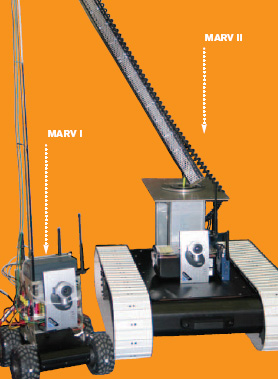Starship it's not "It's funny to see how people react to it. Non-technical people steer wide and won't touch it, while engineers and designers, people you wouldn't think of as given to humor, will stand in front of it until it moves around or put a handkerchief on the wireless camera. Someone even put a 'kick me' sign on it." This is how Ray Tomlin, an engineer at Fermilab, describes reactions to test runs of his latest creation and Fermilab's newest worker: MARV, or Mobile Arm Radiation-measuring Vehicle. While reactions to the 12-inch MARV I and its bigger sibling MARV II have been humorous, the MARVs have a serious job, boldly going where no one has gone before: into the accelerator tunnels while the accelerators are running. MARV is operated remotely through a wireless Internet connection set up inside the Booster tunnel, and can perform a multitude of tasks, which currently include live calibration of beam loss monitors and radiation detection. Other possible uses of MARV include fire suppression and detection of arcs or water leaks without shutting down the beam.
While MARV may not be the Starship Enterprise, its nickel-cadmium battery can power the 8-pound chassis on eight servomotors to achieve a distinctly non-relativistic top speed of two miles per hour for up to three hours. And the cost for MARV was not out of this world. Tomlin, along with help from Fermilab employees Greg Brown, John Larson, and Bob Florian, built MARV I for about $1400 and MARV II for about $5000 through a National Science Foundation grant. Original commercial estimates ran up to $250,000. Despite Ray's characterization of engineers, he has a sense of humor himself. While performing a test run, Ray walked in front of MARV with the block of wood that is MARV's stand. People in the halls stopped and asked him how he was driving it. "I've trained it to follow this block of wood," he said with a straight face. "I think we got a few people to bite."
Click here to download the pdf version of this article. |







